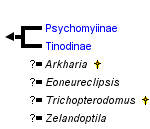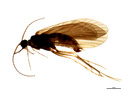Psychomyiidae
Karl Kjer


This tree diagram shows the relationships between several groups of organisms.
The root of the current tree connects the organisms featured in this tree to their containing group and the rest of the Tree of Life. The basal branching point in the tree represents the ancestor of the other groups in the tree. This ancestor diversified over time into several descendent subgroups, which are represented as internal nodes and terminal taxa to the right.

You can click on the root to travel down the Tree of Life all the way to the root of all Life, and you can click on the names of descendent subgroups to travel up the Tree of Life all the way to individual species.
For more information on ToL tree formatting, please see Interpreting the Tree or Classification. To learn more about phylogenetic trees, please visit our Phylogenetic Biology pages.
close boxIntroduction
The family name Psychomyiidae was established by Walker (1852) and has been variably defined throughout the history of caddisfly taxonomy. At one time it included most of the taxa of Annulipalpia other than Philopotamidae and Hydropsychidae. As other families in Annulipalpia were recognized, the name has been more restrictively used. As currently defined, Psychomyiidae is a moderately sized family of net making caddisflies, widespread, but largely centered in the Oriental region and absent in the Neotropical region. Only 1 endemic genus, Zelandoptila Tillyard, with 2 species, is known from New Zealand and Australia. An additional 8 genera are known, of which Tinodes Curtis with 200+ species in the Palaearctic, Oriental, Afrotropical and western Nearctic regions, and Psychomyia Latreille with almost 140 species predominantly from India, and eastern and southeastern Asia, but with several species also from the Holarctic region, are by far the largest. In a gesture of immeasurable kindness, Schmid (1997) established over 40 patronyms for contemporary caddisfly workers when describing new species of Indian Psychomyia. Paduniella Ulmer, with about 50 species, is predominantly Oriental, extending to Indonesia and the Philippines, but also to Africa, the Palaearctic, and (1 species) North America. Other, much smaller genera, include Eoneureclipsis Kimmins (India and Southeast Asia), Lype McLachlan (Holarctic, Oriental, and Afrotropical regions), Metalype Klapalek (Palearctic and Oriental regions), Padangpsyche Malicky (1 species from Sumatra), and Psychomyiella Ulmer (Oriental and eastern Palaearctic regions). (From Holzenthal et al. 2007a).
Characteristics
Most larvae of psychomyiids construct nets formed into elongate, irregularly shaped silken tubes covered with sand and debris and attached to the surface of rocks, tree limbs, or other substrates, in or somewhat above the water level. The larvae apparently graze on diatoms and other algae growing in or near the tubes; they are known to even cultivate algae in the tube’s silken mesh, eating the old portions of the tube while building new portions to serve as silken gardens. The tubes are extended as the larva grows or are moved as the larva interacts with other larvae (Hasselrot 1993). (From Holzenthal et al. 2007a).
Discussion of Phylogenetic Relationships
Li and Morse (1997a, 1997b) provided cladistic analyses of the genera in the family and of the species in Paduniella, respectively. In an analysis of 70 morpholigical characters, Frania and Wiggins (1997) found Xiphocentronidae to be sister to the Psychomyiidae. Kjer et al. (2001) confirmed this in their combined analyses, as well as four independent partitions. The combined analysis of Holzenthal et al. (2007b) also showed this relationship.
References
Frania, H.E. & Wiggins, G.B. (1997) Analysis of morphological and behavioural evidence for the phylogeny and higher classification of Trichoptera (Insecta). Life Sciences Contributions, Royal Ontario Museum, 160, 1–67.
Hasselrot, A.T. (1993) The reason for doodle shaping of galleries in Tinodes waerneri (L.) larvae. In: Otto, C. (Ed.) Proceedings of the 7th International Symposium on Trichoptera. Backhuys Publishers, Leiden, The Netherlands, pp. 267–271.
Holzenthal R.W., Blahnik, R.J., Prather, A.L., and Kjer K.M. 2007a. Order Trichoptera Kirby 1813 (Insecta), Caddisflies. In: Zhang, Z.-Q., and Shear, W.A. (Eds). 2007 Linneaus Tercentenary: Progress in Invertebrate Taxonomy. Zootaxa. 58 pp. 1668:639-698
Holzenthal R.W., Blahnik, R.J., Kjer K.M and Prather, A.L. 2007b. An update on the phylogeny of Caddisflies (Trichoptera). Proceedings of the XIIth International Symposium on Trichoptera. Bueno-Soria, R. Barba-Alvearz and B. Armitage (Eds). pp. 143-153. The Caddis Press.
Kjer, K.M., Blahnik, R.J. & Holzenthal, R.W. (2001) Phylogeny of Trichoptera (caddisflies): characterization of signal and noise within multiple datasets. Systematic Biology, 50, 781–816.
Li, Y.J. & Morse, J.C. (1997a) Phylogeny and classification of Psychomyiidae (Trichoptera) genera. In: Holzenthal, R.W. & Flint, O.S., Jr. (Eds.) Proceedings of the 8th International Sympolium on Trichoptera. Ohio Biological Survey, Columbus, Ohio, pp. 271–276.
Li, Y.J. & Morse, J.C. (1997b) The Paduniella (Trichoptera: Psychomyiidae) of China, with a phylogeny of the World species. Insecta Mundi, 11, 281–299.
Schmid, F. (1997) Le genre Psychomyia en Inde (Trichoptera, Psychomyiidae). Fabreries, 22, 1–56.
Walker, F. (1852) Cataloque of the Specimens of Neuropterous Insects in the Collection of the British Museum, Part I: Phryganides-Perlides. British Museum, London, 192 pp.
Title Illustrations

| Scientific Name | Tinodes sylvia |
|---|---|
| Location | Liguria, Italy |
| Creator | Karl Kjer |
| Specimen Condition | Dead Specimen |
| Identified By | Hans Malicky |
| Life Cycle Stage | Adult |
| View | Lateral |
| Source Collection | Barcode of Life Database (BOLD) |
About This Page
Karl Kjer

Rutgers University, New Brunswick, New Jersey, USA
Correspondence regarding this page should be directed to Karl Kjer at
Page copyright © 2010 Karl Kjer
 Page: Tree of Life
Psychomyiidae.
Authored by
Karl Kjer.
The TEXT of this page is licensed under the
Creative Commons Attribution-NonCommercial License - Version 3.0. Note that images and other media
featured on this page are each governed by their own license, and they may or may not be available
for reuse. Click on an image or a media link to access the media data window, which provides the
relevant licensing information. For the general terms and conditions of ToL material reuse and
redistribution, please see the Tree of Life Copyright
Policies.
Page: Tree of Life
Psychomyiidae.
Authored by
Karl Kjer.
The TEXT of this page is licensed under the
Creative Commons Attribution-NonCommercial License - Version 3.0. Note that images and other media
featured on this page are each governed by their own license, and they may or may not be available
for reuse. Click on an image or a media link to access the media data window, which provides the
relevant licensing information. For the general terms and conditions of ToL material reuse and
redistribution, please see the Tree of Life Copyright
Policies.
- First online 20 July 2010
- Content changed 20 July 2010
Citing this page:
Kjer, Karl. 2010. Psychomyiidae. Version 20 July 2010 (under construction). http://tolweb.org/Psychomyiidae/14557/2010.07.20 in The Tree of Life Web Project, http://tolweb.org/







 Go to quick links
Go to quick search
Go to navigation for this section of the ToL site
Go to detailed links for the ToL site
Go to quick links
Go to quick search
Go to navigation for this section of the ToL site
Go to detailed links for the ToL site